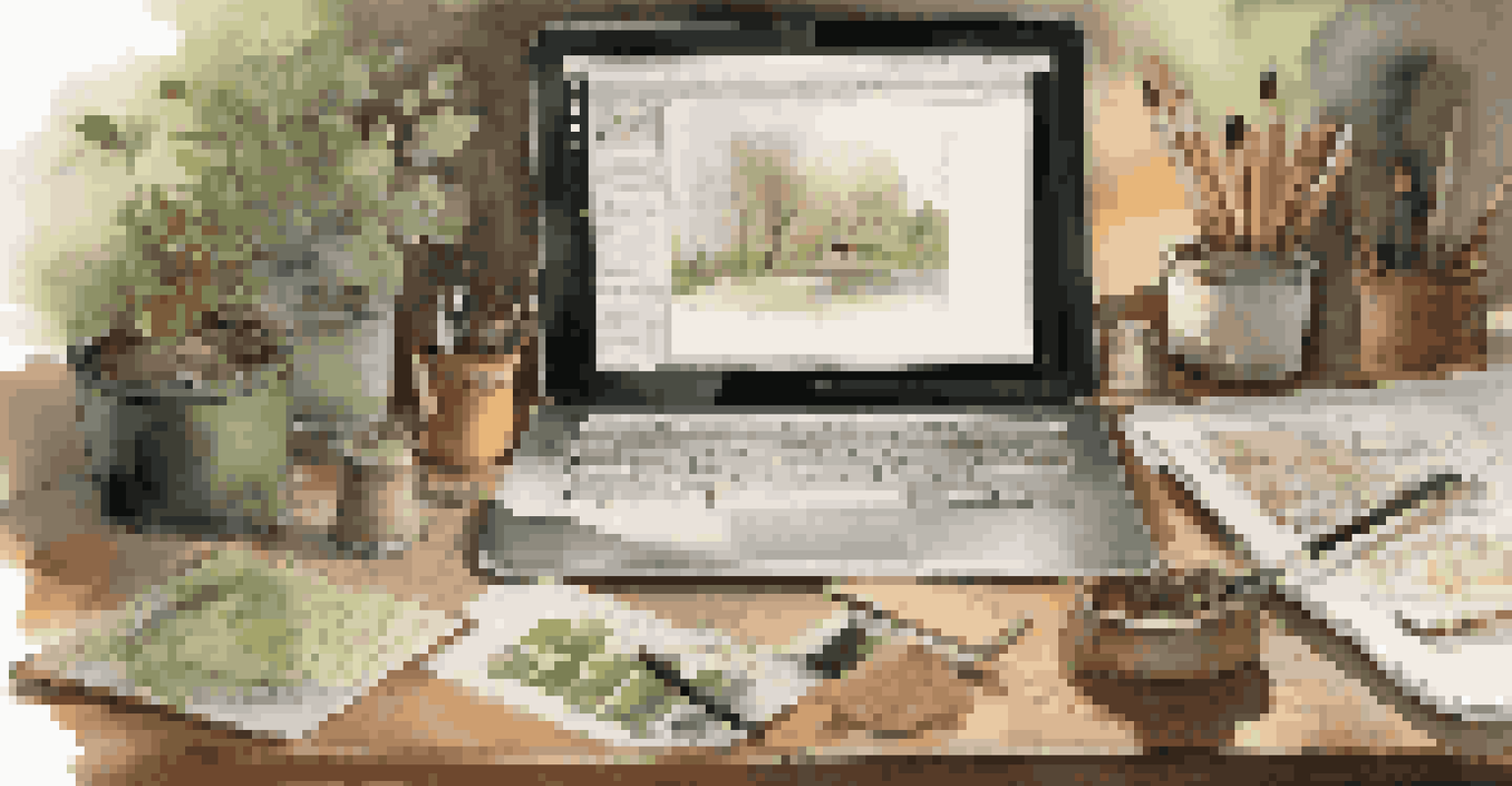Creating Custom Brushes for Digital Painting: A How-To

Understanding the Basics of Digital Brushes
Digital brushes are essential tools in digital painting that mimic traditional painting techniques. They can range from soft, blended strokes to sharp, defined lines, depending on their settings. Understanding how brushes work can significantly enhance your creative process and give your artwork a unique flair.
Every artist was first an amateur.
At the core, a digital brush is made up of various parameters, such as size, shape, opacity, and flow. These settings dictate how the brush interacts with the canvas, allowing for endless possibilities in your artwork. By mastering these basics, you'll be better equipped to create custom brushes that suit your style.
Think of digital brushes like a chef's knives; each serves a distinct purpose in the kitchen. Just as a chef selects the right knife for the task, you can choose or create brushes that help achieve the desired effect in your paintings.
Gathering Inspiration for Your Custom Brushes
Before diving into the creation process, it’s crucial to gather inspiration for your custom brushes. Look around you—nature, architecture, or even textures from everyday objects can spark ideas. Keeping a sketchbook or a digital gallery of interesting textures and shapes can be beneficial.

You can also explore existing brushes created by other artists. Platforms like DeviantArt or Brush Box offer a treasure trove of brushes that can inspire your unique designs. Analyzing how these brushes are built can help you understand what makes them effective.
Master Digital Brushes for Creativity
Understanding the basics of digital brushes enhances your artistic process and allows for unique expression in your artwork.
Remember, inspiration can come from the most unexpected places. Just like an artist finds beauty in the mundane, you can create brushes inspired by your environment, experiences, or even emotions.
Choosing the Right Software for Brush Creation
The software you choose can significantly affect your brush creation experience. Popular choices include Adobe Photoshop, Corel Painter, and Procreate, each offering unique features for brush customization. Familiarizing yourself with the capabilities of your chosen software is essential before starting.
Creativity takes courage.
For instance, Photoshop allows a detailed customization of brushes, featuring options like texture, blending modes, and dynamics. Meanwhile, Procreate offers a more intuitive approach with touch gestures for ease of use. Understanding these differences will help you pick the right tool for your needs.
Think of your software as a canvas; the right one enhances your creativity and allows your custom brushes to shine. Invest time in learning its features to create brushes that truly reflect your artistic vision.
Creating Your First Custom Brush: Step-by-Step
Let’s get hands-on! Start by opening your chosen software and locating the brush creation tool. In Photoshop, for instance, you can find this under the ‘Brush Settings’ menu. Begin with a basic shape, like a round brush, and modify its settings to suit your style.
Experiment with parameters such as size, hardness, and opacity. You can also add textures or change the brush tip shape to create unique effects. Don’t hesitate to play around; the beauty of digital art is the ability to undo mistakes easily.
Gather Inspiration for Brush Design
Finding inspiration from everyday life and existing brushes can spark ideas for creating your own unique digital brushes.
Once you're satisfied with your brush, save it for future use. Just like a special recipe, you want to keep your custom brush safe for your next masterpiece!
Testing and Refining Your Custom Brush
After creating your custom brush, it’s time to test it out! Create a new canvas and start painting with your brush to see how it performs. Pay attention to how the brush interacts with different settings and textures on your canvas.
You may discover that some adjustments are necessary to achieve the desired effect. Don’t be afraid to go back to the settings and tweak parameters like spacing or jitter to refine your brush. This iterative process is key to developing a brush that feels just right.
Just like a sculptor chiseling away at stone, refining your brush will lead to a tool that perfectly captures your artistic intention. Each adjustment brings you closer to your ideal brush.
Using Custom Brushes in Your Digital Artwork
Now that you have your custom brush ready, it’s time to incorporate it into your digital artwork! Custom brushes can add depth, texture, and unique styles to your creations, allowing you to express your artistic vision more effectively. Use them in various ways—whether for backgrounds, details, or even as a primary tool.
Experiment with layering different brushes to create complex textures and effects. For example, combining a soft brush for shading with a textured brush for details can bring your artwork to life. The versatility of custom brushes is one of their greatest strengths.
Share and Sell Your Custom Brushes
Once you've developed your custom brushes, sharing them with the community can foster connections and enhance your reputation as an artist.
As you paint, don’t hesitate to switch between brushes to see which effect works best for your piece. Just like a musician may switch instruments during a performance, varying your brush choices can enhance your artistic expression.
Sharing and Selling Your Custom Brushes
Once you've created a collection of custom brushes, consider sharing them with the digital art community! Platforms like Gumroad or Etsy can be great places to sell your brushes, allowing others to benefit from your creativity. Sharing not only helps others but also builds your reputation as an artist.
You can also share your brushes for free on platforms like DeviantArt or social media. This can foster engagement with fellow artists and inspire others to create their own unique brushes. It’s a wonderful way to contribute to the artistic community.

Think of sharing your brushes as passing on a family recipe. Just as sharing creates connections in a family, sharing your brushes can create bonds within the artistic community, enriching everyone involved.